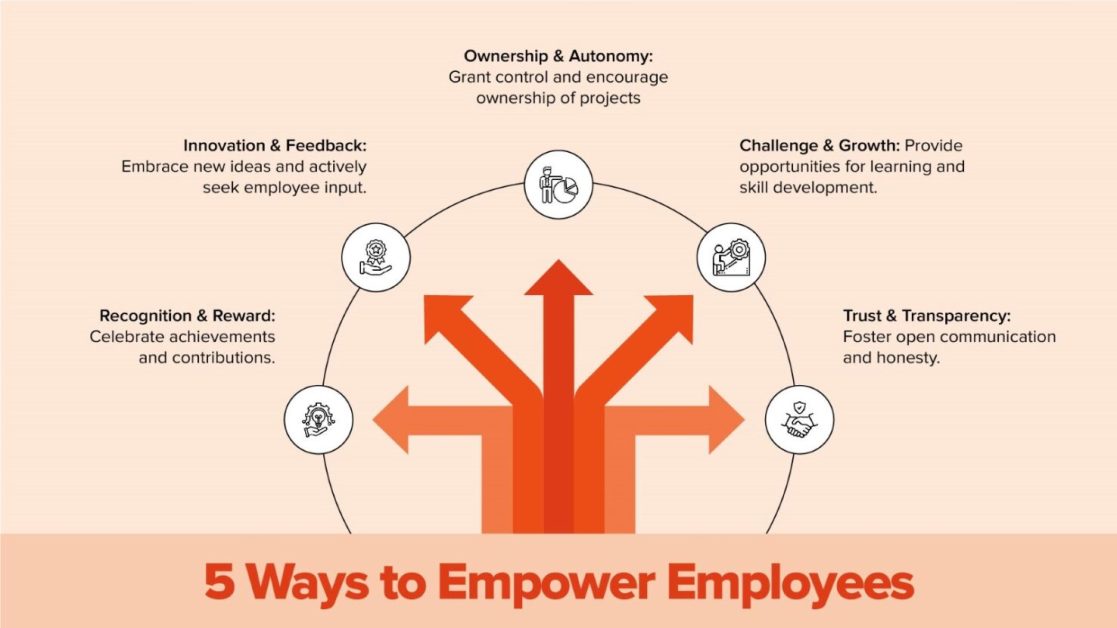In a Nutshell
This blog is a comprehensive guide on employee engagement and empowerment, focusing on practical ways to empower employees. You will learn how to empower people and keep them motivated towards achieving the shared organisational goals.
Employees are your ultimate assets and the driving force of your organisation. If you want success in the long run, then pay attention to your employee’s concerns more than anything. Since engaged employees and empowerment contribute to the company’s success, let’s see how to empower people and foster employee engagement and empowerment.
But how do we achieve this enviable work environment? In this blog, we’ll delve into practical strategies you can follow to engage your workforce, ignite creativity, and build a thriving organisation where everyone feels like a valued contributor.
Trust Employees and Promote Open Communication
A workplace should be an employee’s happy place, where he feels comfortable voicing his thoughts and concerns. To achieve this, you will need to nurture employee engagement and empowerment through trusting and promoting open communication. Here’s how to cultivate a pleasant working environment:
- Hold regular meetings and formal or informal chats to foster two-way communication.
- Pay attention to employees and show genuine interest in their perspectives.
- Keep transparency about company decisions, goals, and challenges.
Remember, openness builds trust and creates a sense of shared responsibility.

Grant Autonomy and Ownership
Micromanagement is the real buzzkill for employees. Step back on micromanaging and give employees control over their work. This doesn’t mean complete free rein but rather provides clear goals and expectations. Grant them the freedom to choose their methods and approaches.
Let employees take ownership of their projects from start to finish.
- Assign challenging yet achievable tasks that match individual strengths and skill sets.
- Trust your team to make decisions and learn from their experiences.
- Recognise and reward employees who go the extra mile and take ownership of their work.
Encourage Employees to Think Out-of-the-Box
Innovation thrives in those workplaces that encourage creativity and exploration. Instead of stifling new ideas, promote out-of-the-box thinking to ignite innovative and problem-solving spirit.
Here are some ways to foster a culture of creativity:
Organise brainstorming sessions where teams come together and generate ideas freely, without judgment or pre-determined solutions. Reward innovative thinking and recognise employees who suggest new ideas, even if they don’t result in immediate implementation.
Another way to bring fresh ideas and approaches is to provide employees with opportunities to learn new skills and attend seminars and workshops.
These are just a few ways to empower employees. You can think of more wellness programs and drive your organisation towards success.
Leadership’s Role in Empowerment
How to empower people? The question often raises voices. Well, it requires more than just delegating tasks – it’s about creating an environment where individuals thrive.
Leaders are the main force who find ways to empower employees and foster an atmosphere of trust, growth, and ownership, ultimately leading to employee engagement and empowerment:
Give Them Working Leverage and Freedom
Provide employees with the resources, tools, and authority needed to complete their work effectively.
Think of a marketing team tasked with creating a new campaign. Instead of dictating every step, a leader could equip the team with a clear budget and campaign goals, enabling them to choose the best channels, strategies, and execution methods.
This nurtures employee engagement and empowerment, motivating them to go above and beyond.
Delegate Tasks and Provide Mentorship
Leaders who empower delegate tasks thoughtfully based on individual strengths and skill sets. They know what allows employees to develop new skills, gain valuable experience, and feel a sense of ownership over their work.
But effective delegation is coupled with ongoing mentorship. The leader’s responsibility should be to create a safe space where employees feel easy to ask questions, seek guidance, and receive constructive feedback.
A supportive environment is necessary to support growth and confidence and nurture employee engagement and empowerment.
Continuously Refine Working Strategies
The business landscape is evolving faster than ever, and successful organisations require adaptation accordingly. Therefore, leaders who focus on employee engagement and empowerment should stay ahead with the technological shifts and make use of modern tools and software like Eazio.
Eazio is the leading HRMS that can help you manage all the tasks so you can focus more on employee engagement.
Moreover, regularly soliciting employee input on processes, workflows, and strategies allows leaders to identify areas for improvement and implement changes based on collective knowledge. This indicates to employees their input is valued, encouraging them to actively contribute to the organisation’s success.
Measure Progress
Empowerment doesn’t happen overnight, and it’s a long-term process to track progress and ensure your efforts are paying off. Metrics can go beyond just traditional performance indicators; consider measuring employee engagement, satisfaction, and innovation.
Regularly monitor these metrics to identify areas of success and areas requiring further nurturing. This data-driven approach helps refine your empowerment strategies and ensure you’re creating an environment where your team can truly thrive.
Conduct Timely Feedback and Surveys
Empowering employees requires a personalised approach that involves careful consideration and continuous adaptation. Regular surveys and feedback are essential to ensure the effectiveness of your efforts.
Here’s why:
Gather valuable insights
Employees are the heart of any organisation, and their perspectives are invaluable. So, there are ways to empower employees; you should regularly conduct anonymous surveys and allow employees to share honest feedback on their experiences, concerns, and suggestions for improvement.
This provides leaders with all the insights into how well their empowerment efforts are working and where adjustments are needed.
Maintain an open dialogue
Feedback should not be just a one-way street. It’s essential to actively listen to employee feedback and demonstrate a willingness to act on it. This shows employees their voices are heard and valued, fostering trust and strengthening the relationship between leadership and team members.
Promote continuous improvement
Feedback and surveys are not just about identifying problems; they’re also opportunities for growth. So, better analyse employee data to identify areas where empowerment strategies are successful and areas for improvement.
Continuously refine approaches to ensure that the organisation is evolving and meeting all needs of its employees.
Conclusion – Employee Engagement and Empowerment
Employee engagement and empowerment are powerful forces working together to drive organisational success. Since you now know How to empower people, let’s quickly recall everything. You need an environment of trust, autonomy, and continuous learning so leaders can unlock the full potential of their workforce.
Remember, empowerment is more than just a strategy; it’s a mindset. So, create a well-structured environment for your people. Employees feel valued, respected, and capable, which leads to increased engagement, innovation, and, ultimately, a thriving organisation.
Take the first step today! Start fostering a culture of empowerment and watch your team and your business flourish.
- Tayaba Aslam
5 min
Frequently Asked Questions - FAQs
What are the benefits of a cloud-based solution?
How does a cloud-based solution benefit you?
Does Eazio comply with all UAE payroll and labour laws?
Is it possible to test Eazio before deciding whether to use it?
Absolutely! Once you’ve signed up, a team member will contact you to set up your account.
Does Eazio have a mobile application?
Yes, Eazio does have a mobile application.
Can Eazio be integrated with other systems?
Yes, of course! You can integrate Eazio natively with virtually any cloud service.
Let's Connect!
We would love to discuss your HR needs.
Related blogs

The Future of Work: How HR Tech is Shaping Tomorrow’s Workforce
5 min
Sharukh
May 22, 2025


